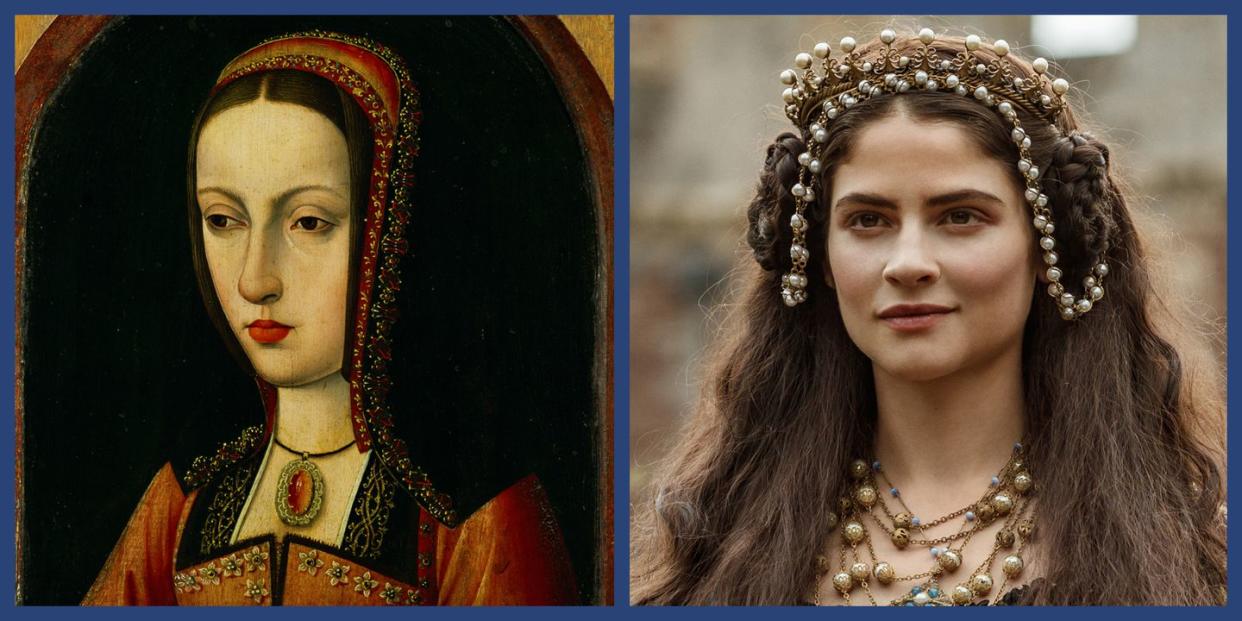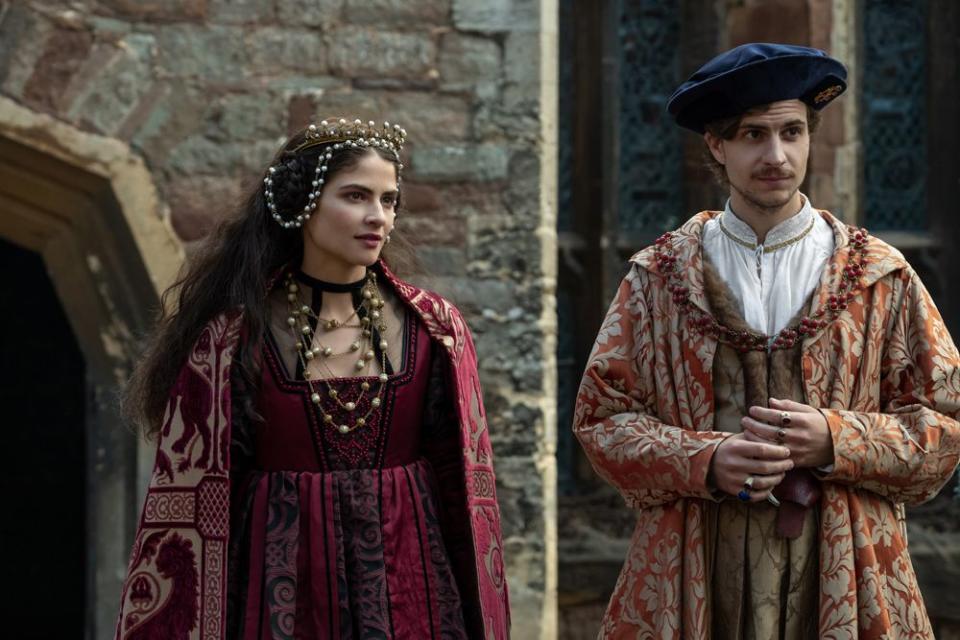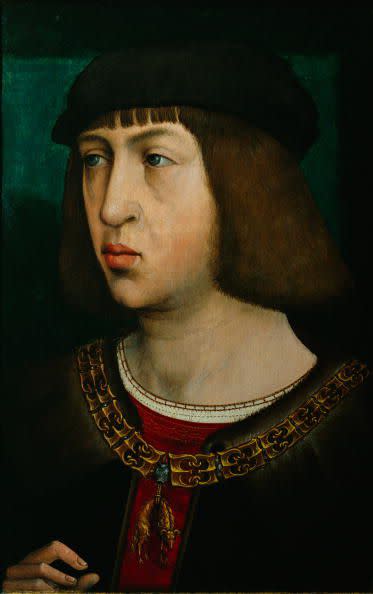What Was Catherine of Aragon's Sister, Juana la Loca, Really Like?

Catherine of Aragon had a famously fraught time as Queen, but for all the turmoil that her marriage to King Henry VIII entailed, Catherine was not the only woman in her family to find tribulations awaiting her on the throne. In fact, one could argue that Catherine's older sister, Juana, as seen on this week's episode of The Spanish Princess, had even worse luck when it came to ruling.
While Catherine's marriage to Henry would lead to divorce, a religious revolution, and a struggle over succession that would stretch for generations, her sister would ultimately find herself, through a series of circumstances largely beyond her control, going down in history best known as Juana la Loca-Juana the Mad.

Groomed for Greatness
Sometimes Anglicized as Joan or Joanna, Juana was born on November 6, 1479, the third child and second daughter of Queen Isabella I of Castile and King Ferdinand II of Aragon.
Prior to Isabella and Ferdinand's marriage, Castile, which made up a large portion of the northern and central Iberian peninsula, and Aragon, which encompassed the northeastern region, were separate kingdoms. Though the marriage between Isabella and Ferdinand united the two crowns, establishing the kingdom of Spain, Castile and Aragon continued to maintain their own separate political and governmental structures and functioned essentially as separate countries; despite ruling over Spain together with his wife, Ferdinand had no legal claim on the Castilian throne, nor did Isabella on the crown of Aragon-a fact that would become tragically pivotal in Juana's life.
Juana's mother, Isabella I, was an ardent Catholic (she was granted the right to style herself as Isabella the Catholic by Pope Alexander VI) and the Spanish Inquisition began during her reign. Juana, however, never showed the same level of religious devotion and, according to some sources, was brutally punished by her mother for her more moderate faith.
Having both an older sister, Princess Isabella, and an older brother, Prince Juan, Juana was considered unlikely to ever ascend to the throne in her native Spain, however that hardly meant that she wasn't expected to be a Queen. Educated in politics, languages, and music, Juana was groomed from childhood to stand alongside one of the kings of Europe in a political marriage that would strengthen Spain's foreign alliances.

An Impromptu Wedding
That political marriage came in the form of a two-part deal with Maximilian I, the Austrian emperor, who agreed to marry his eldest son and heir, Philip the Fair, to Juana and his daughter, Margaret, to Juan.
After months of planning, the 16-year-old Juana sailed to Flanders with a fleet of over 100 ships in August of 1496. Storms at sea delayed her arrival; however, she was finally able to meet her intended on October 19 of that year. Their wedding was already planned for the following day, but evidently the first meeting between the two young royals was a dramatic success-rather than waiting, they ordered a priest to marry them on the spot.
Together the two would go on to have six children, including Charles V, who would become King of Spain and the Holy Roman Emperor, Ferdinand, who succeeded his brother as Holy Roman Emperor, and four daughters, all of who would go on to become queens in their own right-Eleanor (who was a various points Queen of Portugal and Queen of France); Elizabeth, Queen of Denmark; Maria, Queen of Hungary; and Catherine, who married the successor of her sister Eleanor's husband to also become Queen of Portugal.
Despite their apparent passion, Juana's husband Philip was frequently unfaithful to her, his indiscreet affairs causing Juana to fly into rages and periods of depression that provoked the first rumors about Juana's mental state.

An Unexpected Throne
Given that she was third in line for the throne with two married siblings, it came as a surprise to all when it was Juana who ascended as Queen of Castile.
Her brother and heir to both of their parents' thrones, Juan, died of an illness in the fall of 1497, and though his wife, Margaret of Austria, was pregnant at the time, the child was stillborn. From there, the position of heir briefly went to Juana's older sister, Isabella of Asturias, but she died in childbirth less than a year later. Her son, Prince Miguel survived to the age of two before passing, leaving Juana as the heir to Castile and Aragon.
With the rise in status, Juana became increasingly politically useful and Philip began attempting to assert increasing control over his independent-minded wife. The couple fought openly and Philip had Juana confined to her rooms for a time. In retaliation, Juana would often employ a method that she had utilized throughout her life, refusing to eat or sleep as a form of passive protest.
Trapped Between Her Husband and Her Father
It was not until November 26, 1504, when Isabella I died that Juana would take the title of Queen of Castile, but the transition was far from smooth.
Both Philip and Juana's father, Ferdinand II wanted to control Castile, but Isabella, in her fear that the people of Castile would not accept a foreign king, had complicated matters for them by stipulating that Philip could only act as consort to Juana, unless she proved unfit to rule, in which case Ferdinand was to take up governance as a regent until Juana's son Charles came of age.

Ferdinand quickly took up a campaign declaring his daughter mentally incompetent and styling himself as the rule of Castile. It was en route to take a stand against his claims in 1506 that Juana and Philip would find themselves in England courtesy of storms. There Juana was briefly reunited with her sister, Catherine, who by then had been widowed by Prince Arthur, though not yet married to Henry VIII.
Henry's father, Henry VII, supported Philip's control of Castile over Ferdinand, and his power may in part have influenced Ferdinand's agreement to cede Castile in favor of military and monetary support.
Philip had planned to exert further control over his wife, rendering her a figurehead for Castile, however his plans were cut short by his own death in 1506. According to writers of the period, Juana refused to leave the body's side for months, frequently having Philip's casket reopened to gaze upon and even kiss his corpse. It is unclear how accurate these accounts were, however, as access to Juana after this time was heavily limited by her father, and later her son Charles, both of whom had a stake in ensuring that Juana was known to be insane.

Queen of Castille and Aragon
In July of 1507, Juana handed over the regency of Castile to her father. Juana herself had never shown any particular inclinations towards governance, but nonetheless there are strong suggestions that the decision to leave the ruling of Castile to Ferdinand was not entirely of Juana's own volition.
Regardless of the nature of Ferdinand's regency, Juana most certainly didn't consent to her enforced sequester at his hands. Ferdinand had his daughter ensconced at the royal palace in Tordesillas in 1509 along with her youngest daughter, Catherine. In the seven years she remained functionally jailed there, her father is said to have visited only twice.
When Ferdinand died in 1516 making Juana Queen of Castille and Aragon, her son Charles took up the role as his mother's jailer, briefly removing the 11 year old Catherine from her care before ultimately returning her when Juana refused to eat. Charles forbid anyone from telling his mother of Ferdinand's death and kept her even more isolated than she had been under his father's control.
Juana was briefly freed by rebels who wanted her to rule as the rightful Queen of Castile after Charles became Holy Roman Emperor in 1509, but Juana was uncooperative and after almost of year of freedom, was returned to Tordesillas when Charles stamped out the resistance. He also removed Catherine from her care once, again, this time to marry her to King John III of Portugal.
Imprisonment and Death
Juana remained in the palace at Tordesillas for the remaining 30 years of her life, though not much is known about her time there. She died, still held captive, in April of 1555 at the age of 75.

The Madness of Juana
Though, obviously, it would be impossible to accurately diagnose a mental illness at the remove of several centuries, it does appear that Juana did indeed suffer from some form of psychological disorder. Scholars throughout the years have cited a variety of possibilities ranging from depression to schizophrenia to a form of bipolar disorder.
The theory is supported by Juana's maternal grandmother, Isabella of Portugal, who apparently suffered from her own psychological issues, including paranoia, which could indicate a hereditary factor.
Nonetheless, it was to the benefit of the men who controlled her to spread the story of Juana's mental instability and it is possible that some accounts were exaggerated for this purpose. Regardless, given the number of male rulers in European history that were also of questionable mental fitness, it seems unlikely that any mental health issues Juana may have suffered from would have ended in her imprisonment and removal from power if she had been king instead of queen.
('You Might Also Like',)

